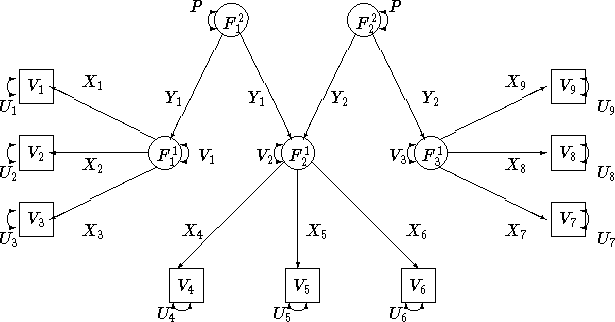RAM Model Statement
- RAM list-entry < , list-entry ... > ;
where list-entry represents
matrix-number row-number column-number <value><parameter-name>
The RAM statement defines the elements of the symmetric RAM matrix model

in the form of a list type input (McArdle and McDonald 1984).
The covariance structure is given by
-
C = J(I- A)-1P((I- A)-1)'J'
with selection matrix J and

You can specify only one RAM statement with each PROC CALIS statement.
Using the RAM statement requires that the first n variable
numbers in the path diagram and in the vector v correspond
to the numbers of the n manifest variables of the given covariance
or correlation matrix. If you are not sure what the order
of the manifest variables in the DATA= data set is, use a
VAR statement to specify the order of these
observed variables. Using the AUGMENT option includes the
INTERCEPT variable as a manifest variable with number n+1 in the
RAM model. In this case,
latent variables have to start with n+2.
The box of each manifest variable in the path diagram is
assigned the number of the variable in the covariance
or correlation matrix.
The selection matrix J is always a rectangular
identity (IDE) matrix, and it does not have to be specified
in the RAM statement.
A constant matrix element is defined in a RAM statement by a
list-entry with four numbers. You define a parameter element
by three or four numbers followed by a name for the parameter.
Separate the list entries with a comma. Each list-entry in
the RAM statement corresponds to a path in the diagram, as follows:
- The first number in each list entry (matrix-number) is
the number of arrow heads of the path, which is the same
as the number of the matrix in the RAM model
(1 := A , 2 := P).
- The second number in each list entry (row-number)
is the number of the node in the diagram to which the path points,
which is the same as the row number of the matrix element.
- The third number in each list entry (column-number)
is the number of the node in the diagram from which the path originates,
which is the same as the column number of the matrix element.
- The fourth number (value) gives the (initial) value of
the path coefficient. If you do not specify a fifth list-entry,
this number specifies a constant coefficient; otherwise, this number
specifies the initial value of this parameter. It is not necessary
to specify the fourth item. If you specify neither the fourth nor
the fifth item, the constant is set to 1 by default.
If the fourth item (value) is not specified for a parameter,
PROC CALIS tries to compute an initial value for this parameter.
- If the path coefficient is a parameter rather than a constant,
then a fifth item in the list entry (parameter-name)
is required to assign a name to the parameter.
Using the same name for different paths constrains
the corresponding coefficients to be equal.
If the initial value of a parameter is not specified in the list,
the initial value is
chosen in one of the following ways:
- If the PROC CALIS statement contains a RANDOM=i
option, then the parameter obtains
a randomly generated initial value r,
such that
 . The uninitialized parameters in the diagonals of the
central model matrices are given the random values
r multiplied by 10, 100, or the value specified
in the DEMPHAS= option.
. The uninitialized parameters in the diagonals of the
central model matrices are given the random values
r multiplied by 10, 100, or the value specified
in the DEMPHAS= option.
- If the RANDOM= option is not used, PROC CALIS tries to estimate
the initial values.
- If the initial values cannot be estimated,
the value of the START= option is used as an
initial value.
If your model contains many unconstrained
parameters and it is too cumbersome to find
different parameter names, you can specify all those
parameters by the same prefix name. A prefix is a short
name followed by a colon. The CALIS procedure then
generates a parameter name by appending an integer suffix
to this prefix name. The prefix name should have no
more than five or six characters so that the
generated parameter name is not longer than eight
characters. To avoid unintentional equality constraints,
the prefix names should not coincide with explicitly
defined parameter names.
For example, you can specify the
confirmatory second-order factor analysis
model
-
S = F1 F2 P2 F2' F1' + F1 U22 F1' + U12
using the following RAM model statement.
ram
1 1 10 x1,
1 2 10 x2,
1 3 10 x3,
1 4 11 x4,
1 5 11 x5,
1 6 11 x6,
1 7 12 x7,
1 8 12 x8,
1 9 12 x9,
1 10 13 y1,
1 11 13 y1,
1 11 14 y2,
1 12 14 y2,
2 1 1 u:,
2 2 2 u:,
2 3 3 u:,
2 4 4 u:,
2 5 5 u:,
2 6 6 u:,
2 7 7 u:,
2 8 8 u:,
2 9 9 u:,
2 10 10 v:,
2 11 11 v:,
2 12 12 v:,
2 13 13 p ,
2 14 14 p ;
run;
The confirmatory
second-order factor analysis model corresponds to the path diagram
displayed in Figure 19.2.

Figure 19.2: Path Diagram of Second-Order Factor Analysis Model
There is a very close relationship between the RAM
model algebra and the specification of structural linear models by
path diagrams. See Figure 19.3 for an example.

Figure 19.3: Examples of RAM Nomography
Refer to McArdle (1980) for the interpretation of the models displayed
in Figure 19.3.
Copyright © 1999 by SAS Institute Inc., Cary, NC, USA. All rights reserved.



